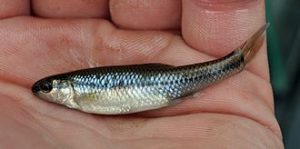By Jack MacRae and Gary Mechanic
Rolling in the River
T heir name might make them sound like they’re Mick Jagger groupies, but common stonerollers are actually local minnows named for their nest construction technique. Beginning in the first several weeks of spring as Fox River tributaries warm into the 50-degree range, and continuing into mid-summer, male stonerollers use their protruding lips and tubercle-covered faces to push gravel in clean flowing streambeds to create a bowl shaped depression that has a curiously stimulating effect on female stonerollers. The males defend their excavations with tenacity until the females place their sticky eggs in the nests where they are fertilized. The rock and roll parents then abandon the nests to party downstream. The hatchlings will develop in the current alongside hundreds of other orphaned stonerollers who (like many modern teens) don’t do much but eat and party. An interesting note: while the Rolling Stones idolized bluesman Muddy Waters, stonerollers don’t like muddy waters at all. They prefer clear-flowing riffles with a skiffle beat.
heir name might make them sound like they’re Mick Jagger groupies, but common stonerollers are actually local minnows named for their nest construction technique. Beginning in the first several weeks of spring as Fox River tributaries warm into the 50-degree range, and continuing into mid-summer, male stonerollers use their protruding lips and tubercle-covered faces to push gravel in clean flowing streambeds to create a bowl shaped depression that has a curiously stimulating effect on female stonerollers. The males defend their excavations with tenacity until the females place their sticky eggs in the nests where they are fertilized. The rock and roll parents then abandon the nests to party downstream. The hatchlings will develop in the current alongside hundreds of other orphaned stonerollers who (like many modern teens) don’t do much but eat and party. An interesting note: while the Rolling Stones idolized bluesman Muddy Waters, stonerollers don’t like muddy waters at all. They prefer clear-flowing riffles with a skiffle beat.
Flowers Afoot
 The birdsfoot violet is no shrinker. This sun-loving violet lives in open black oak savanna, sandy prairies, and gravelly hillsides with acidic soils. It thrives in some dazzling patches in the Fox River Valley. The birdsfoot has a typical violet-shaped flower with five soft lavender petals and a bright yellow center. In some locations the flower of the bird’s foot violet is bicolored; a very attractive combination of light blue petals on the bottom and dark purple petals on top. The leaves are distinctively long, slender and somewhat reminiscent of bird toes, hence the name.
The birdsfoot violet is no shrinker. This sun-loving violet lives in open black oak savanna, sandy prairies, and gravelly hillsides with acidic soils. It thrives in some dazzling patches in the Fox River Valley. The birdsfoot has a typical violet-shaped flower with five soft lavender petals and a bright yellow center. In some locations the flower of the bird’s foot violet is bicolored; a very attractive combination of light blue petals on the bottom and dark purple petals on top. The leaves are distinctively long, slender and somewhat reminiscent of bird toes, hence the name.

